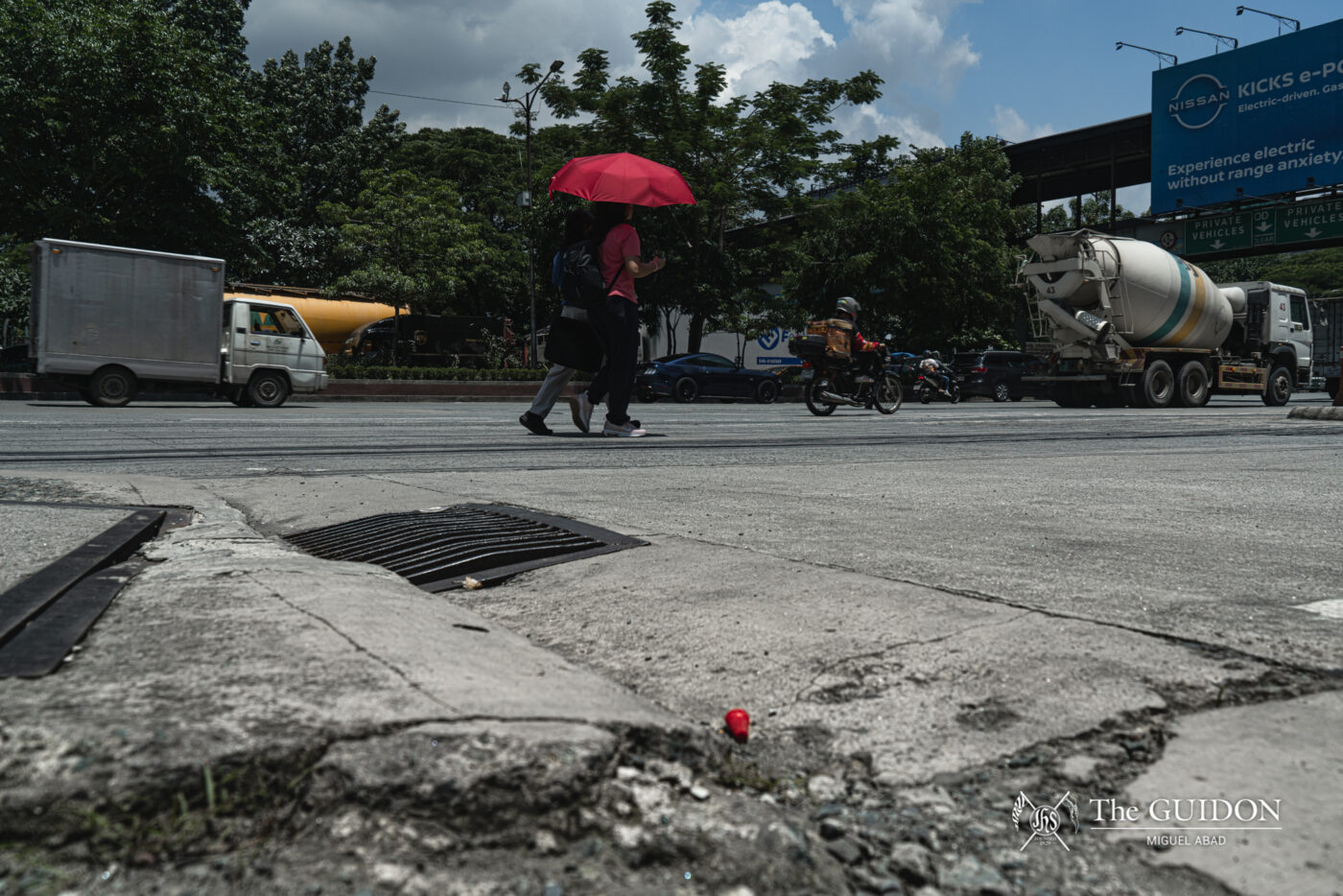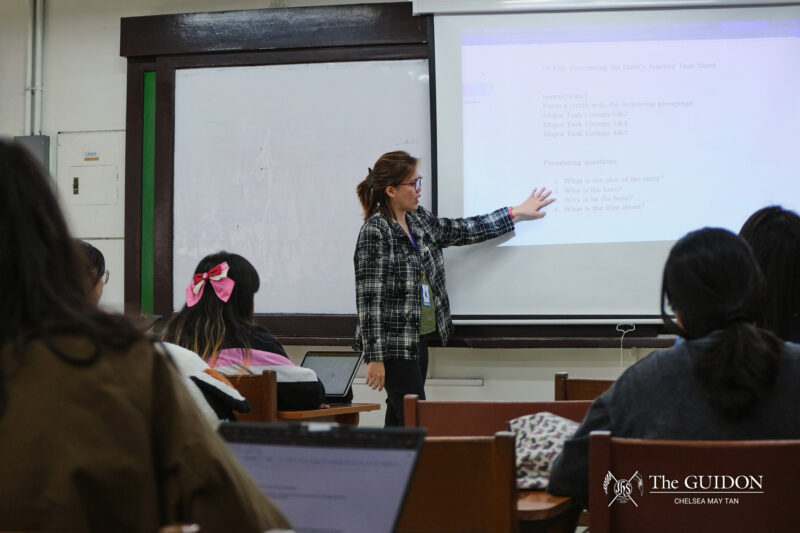RAINFALL REMAINS an integral concern in the experiences of those walking along Katipunan. As puddles form in the dips and cracks of the sidewalks’ pavements, traversing the Avenue becomes a greater challenge during the rainy season.
In 2019, the Metropolitan Manila Development Authority (MMDA) reported that Katipunan Avenue was one of the most flood-prone areas, citing its inadequate draining capacity as a key factor.
This susceptibility to floods was recently observed during the onslaught of Typhoon Carina, with knee-deep floods barring pedestrians and vehicles from crossing the Avenue. Furthermore, while roads were passable amid the heavy rainfall brought by Severe Tropical Storm Enteng, Katipunan still experienced four inches of flooding in some areas.
According to the MMDA and the Department of Public Works and Highways, other factors also influence an area’s flood resistance, such as obstructed drainage systems and insufficient tree populations. Thus, as Katipunan remains susceptible to flooding, the community’s call to improve the area’s urban planning and flood prevention initiatives grows increasingly urgent.
Anticipating the storm
For off-campus dormers like Nat Fuñe (4 BS HS), living alone during the rainy season in Metro Manila has consistently proved to be a disruptive hassle. His dormitory is located along Esteban Abada, a street with areas of ankle-deep flooding from heavy rainfall.
Having been a dormer for years, Fuñe shares that whenever weather forecasts report severe rainfall, he prioritizes securing food and toiletries in preparation for staying indoors. In the lead-up to the intense rains of Typhoon Carina over Quezon City (QC), Fuñe says that he already had supplies prepared to last him a few days.
Despite being accustomed to such emergencies, he admits to still experiencing difficulties in walking during weather disturbances. During strong rains, the downpour makes walking challenging because of puddles and debris obstructing sidewalks. To get home, Fuñe feels forced to either use transportation services or to wait for the storm to subside.
Such challenges suggest underlying issues in the Katipunan’s structural planning. Environmental Science Department Chair Ma. Aileen Leah G. Guzman, PhD states that converting green areas into paved roads and concrete structures decreases rainwater infiltration, directing flow instead onto footpaths and sidewalks.
Likewise, Guzman notes how more condominiums necessitate a recalculation of Katipunan’s drainage capacity. However, building design regulations do not sufficiently account for flood preparedness. As such, further modeling is required to ensure that rainwater flow does not exacerbate flooding in nearby areas.
Amid rapid urban growth, Fuñe also attributed flooding concerns to nearby developments that cut down trees and strain inadequate drainage systems. Additionally, dormers like him remain concerned about the lack of government efforts to improve the area’s flood resistance.
“Along Katipunan especially in front of Ateneo, there’s three ongoing constructions […] it says a lot about how buildings nowadays dominate to maximize the space for industrial buildings and parking spaces,” he mentioned.
Concrete development
While individual disaster preparedness is encouraged, addressing Katipunan Avenue’s flood susceptibility also requires a reappraisal of its current infrastructure-oriented urban development.
In 2009, the MMDA conducted tree-cutting and earth-balling operations as part of a road-widening project along Katipunan Avenue. Notably, a cease and desist order was issued by the Department of Environment and Natural Resources (DENR) against the MMDA for its supposed violation of the presidential decree on unauthorized tree-cutting. However, the MMDA argued that only tree relocations took place, which was allowed under their agreement with DENR.
Aside from this, the construction of SM Development Corporation Blue Residences sparked uproar among the Loyola Heights Community. With the residences exceeding the 24-story height limit permitted in the city’s comprehensive zoning ordinance, the 41-story condominium was granted a zoning exemption by the QC Council.
Moreover, the Loyola Heights Park was demolished in 2022 for the construction of a “Three-Storey Parking Building with Roof Deck.” However, Barangay Loyola Heights Kagawad Leticia P. Palanog clarified that the project is currently on hold, in order to incorporate it with other planned renovations.
Throughout the years, local community stakeholders have protested against real estate development, emphasizing its environmental consequences. However, major entities—often banking on political patronage to bypass local ordinances—have always gained the upper hand.
Barangay Loyola Heights Kagawad Sherwin L. Lazar acknowledged that these urban developments pose detrimental consequences to local affairs, especially in terms of waste management and the supply of essential utilities.
As such, to assess the effects of infrastructure projects, he stated that the barangay holds sectoral consultations and public hearings within their jurisdiction. However, the councilors shared that their decisions are usually superseded by the QC Council, the local body that issues construction permits to developers.
Thus, in the event of torrential rains and flooding, the barangay carries out disaster risk reduction and management efforts instead, which include clean-up drives, anti-dengue fumigation, leptospirosis antibiotic distributions, and other rescue and relief operations.
Redirecting the currents
As multi-story buildings continue to rise along Katipunan, flood resistance is compromised if developers fail to account for expected rainfall from typhoons. To address flooding concerns, government units have begun coordinating with relevant stakeholders in creating new initiatives.
In 2020, the QC local government partnered with the University of the Philippines Resilience Institute (UPRI) to develop the QC Comprehensive Drainage Master Plan. In the master plan, the UPRI uses flood sensors to find vulnerabilities and improvements for the city’s water management systems.
Aside from this, the MMDA also conducted drainage improvements along Katipunan in 2022, including the installment of garbage traps along waterways and the regular dredging of canals and drainages.
To ensure the long-term effectiveness of such initiatives, Guzman stresses the need for their consistent implementation. “You have to do [these initiatives] on a regular basis and that’s part of the maintenance of your drainage canals, or you could be strict with implementing waste management laws,” she expounds.
Moreover, she cites successful flood prevention initiatives from other countries, such as New York City’s rain gardens, which are deep-rooted plants placed along sidewalks to absorb rainwater. Another is Singapore’s Marina Barrage, a dam that alleviates the flooding in low-lying city areas while boosting the country’s water supply.
However, Guzman emphasizes that these initiatives should not be applied without tailoring them to our local needs. As such, she hopes for more transparency with the government’s processes in consulting environmental scientists to improve these initiatives.
As the attempts to address Katipunan’s flood susceptibility move toward prevention rather than recovery, better coordination between residents, government offices, and private developers is crucial in bringing these attempts to fruition.







